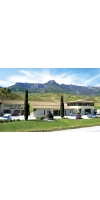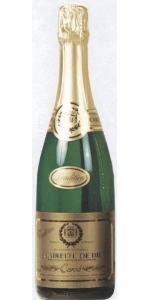Wine from Caves Carod Freres

The Caves Carod Freres Estate
In 1973, Alain and Marcel Carod took over the winery that was founded by their grand father. Caves Carod are located in the heart of the appellation. Cave Carod is the second largest of 20 producers of Clairette de Die in the region. The brothers make wine from their own vineyard and act also as wine merchants. Modern equipment combined with traditional winemaking and extensive production control enable them to create quality wines. They produce around 111,111 cases per year, 90% Clairette de Die and 10% Crémant de Die, and 30% of their production is exported.In April 2008, Cave Carod was acquired by "Les Grands Chais de France".
The Caves Carod Freres Vineyards
The A.O.C. Clairette de Die spreads over 1,300 hectares (3,211 acres) and 32 villages, located on hillsides. The soils are clay and limestone based. These types of soils are difficult to work with but together with the climate, rigorous grape selection and careful cultivation of the vine (an ancestral tradition), can produce very fine wines with individual flavors. The vineyard's altitude (over 700 meters) makes it one of the highest in France. Carod brothers farm 50 hectares of land (123.50 acres).
.
Cave Carod Clairette de Die is made from 75% Muscat Petits Grains and 25% Clairette. Clairette de Die is produced with the ancestral dioise method.
The grapes are rapidly pressed after the harvest and then placed in vats at low temperatures (replicating the process used by the Voconces in ancient times who kept the jars in the icy waters of their local rivers). The half-fermented must is bottled and fermentation continues in the bottle, giving a naturally sparkling wine. Disgorging occurs at least six months after bottling, while the wine still contains sugar and has reached an alcohol content of 7 to 9 %.
This is a sparkling wine with very fine bubbles, light in alcohol (8°), and containing residual sugar (incomplete fermentation). Clairette de Die has been known since ancient times (dates back to 77 A.D.). Clairette brings delicacy and lightness to the wine whereas Muscat gives its typical sweet flavor. The wine displays intense aromas, a refreshing balance of fruit and acidity with peach, orange and white flowers flavors.
This is an ideal wine for all desserts and ice creams, and is very interesting with foie gras. It is especially suitable for daytime meetings and cocktail parties. A great breakfast wine!
Wine to be consumed young, to conserve the full fruity and floral flavors. To be stored flat in a cool room away from light.
GOLD MEDAL - Effervescents du Monde 2010
GOLD MEDAL - Concours General Agricole de Paris 2012
SILVER MEDAL - Concours General Agricole de Paris 2011
- back
Selected Options
Wineries
Categories
Pricing
Countries
Regions
Grape Types
Wineries
Organic/Free Shipping
TYPE: DOCG
GRAPE VARIETY: 100% Sangiovese harvested from the oldest vineyards.
VINIFICATION: Alcoholic fermentation with maceration of the skins (25-30 days) at a controlled temperature and spontaneous malolactic fermentation, both in truncated cone-shaped Slavonian oak vats.
REFINEMENT: In Slavonian oak barrels from 10 to 32 hl for approx. 34-38 months; followed by bottle refinement of at least 6 months.
ON SALE BY:January of the 5th year after the harvest.
NOTE:
Color: intense ruby with garnet reflections.
Perfume: ethereal, of red fruit and vanilla, persistent.
Taste: harmonious, with excellent tannins and structure, very persistent.
Food pairings: roasted red meats, game, mature cheeses.
Review:
A jeweled ruby color, the 2019 Brunello Di Montalcino is forward with licorice spice on the nose and opens to notes of fresh black cherries, pine, and toasted rosemary. Medium to full-bodied, it offers wonderful energy from the start, with balanced, angular structure, ripe tannins, crunchy fresh acidity, and a long finish. Avery well styled Brunello, it will be in its prime in the coming 10-15 years.
-Jeb Dunnuck 95 Points
Aromas of redcurrants and red flowers, followed by a touch of pie crust and sandalwood. Full-bodied with steely and sturdy tannins and vivid acidity. Dried-herb character at the end. Masculine and structured. Hold until 2027.
-James Suckling 95 Points
Chakana Singular Torrontes de Maceracion Prolongada is 100% Torrontes.
Deep, orange color.
Complex nose, notes of white flowers, peaches, evolution and skins aromas. Nice texture, good structure, final minerality, perfectly balanced by good freshness.
Chakana is the name of the Southern Cross constellation. Its rotation in the sky throughout the year made it an effective agricultural calendar for the ancient Andean people.





